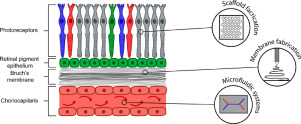当前位置:
X-MOL 学术
›
Acta Biomater.
›
论文详情
Our official English website, www.x-mol.net, welcomes your feedback! (Note: you will need to create a separate account there.)
Bio-inspired human in vitro outer retinal models: Bruch's membrane and its cellular interactions.
Acta Biomaterialia ( IF 9.7 ) Pub Date : 2020-01-13 , DOI: 10.1016/j.actbio.2020.01.013 Ashley R Murphy 1 , Yen B Truong 1 , Carmel M O'Brien 2 , Veronica Glattauer 1
Acta Biomaterialia ( IF 9.7 ) Pub Date : 2020-01-13 , DOI: 10.1016/j.actbio.2020.01.013 Ashley R Murphy 1 , Yen B Truong 1 , Carmel M O'Brien 2 , Veronica Glattauer 1
Affiliation

|
Retinal degenerative disorders, such as age-related macular degeneration (AMD), are one of the leading causes of blindness worldwide, however, treatments to completely stop the progression of these debilitating conditions are non-existent. Researchers require sophisticated models that can accurately represent the native structure of human retinal tissue to study these disorders. Current in vitro models used to study the retina are limited in their ability to fully recapitulate the structure and function of the retina, Bruch's membrane and the underlying choroid. Recent developments in the field of induced pluripotent stem cell technology has demonstrated the capability of retinal pigment epithelial cells to recapitulate AMD-like pathology. However, such studies utilise unsophisticated, bio-inert membranes to act as Bruch's membrane and support iPSC-derived retinal cells. This review presents a concise summary of the properties and function of the Bruch's membrane-retinal pigment epithelium complex, the initial pathogenic site of AMD as well as the current status for materials and fabrication approaches used to generate in vitro models of this complex tissue. Finally, this review explores required advances in the field of in vitro retinal modelling. STATEMENT OF SIGNIFICANCE: Retinal degenerative disorders such as age-related macular degeneration are worldwide leading causes of blindness. Previous attempts to model the Bruch's membrane-retinal pigment epithelial complex, the initial pathogenic site of age-related macular degeneration, have lacked the sophistication to elucidate valuable insights into disease mechanisms. Here we provide a detailed account of the morphological, physical and chemical properties of Bruch's membrane which may aid the fabrication of more sophisticated and physiologically accurate in vitro models of the retina, as well as various fabrication techniques to recreate this structure. This review also further highlights some recent advances in some additional challenging aspects of retinal tissue modelling including integrated fluid flow and photoreceptor alignment.
中文翻译:

受生物启发的人体外视网膜模型:布鲁赫膜及其细胞相互作用。
视网膜变性疾病,例如与年龄有关的黄斑变性(AMD),是全世界失明的主要原因之一,但是,尚不存在能够完全阻止这些使人衰弱的疾病进展的治疗方法。研究人员需要能够准确代表人类视网膜组织天然结构的复杂模型来研究这些疾病。当前用于研究视网膜的体外模型在完全概括视网膜,布鲁赫膜和基础脉络膜的结构和功能方面的能力有限。诱导性多能干细胞技术领域的最新进展表明,视网膜色素上皮细胞具有概括AMD样病理的能力。但是,此类研究利用了不复杂的生物惰性膜来充当Bruch' 膜并支持iPSC衍生的视网膜细胞。这篇综述简要概述了布鲁赫膜-视网膜色素上皮复合物的特性和功能,AMD的最初致病部位以及用于生成该复合物组织体外模型的材料和制造方法的当前状态。最后,本文探讨了体外视网膜建模领域的必要进展。意义声明:视网膜退行性疾病,例如与年龄有关的黄斑变性,是全世界失明的主要原因。先前对布鲁赫膜-视网膜色素上皮复合物(与年龄相关的黄斑变性的初始致病部位)进行建模的尝试,缺乏阐明疾病机制有价值的见解的技巧。在这里,我们提供了Bruch膜的形态,物理和化学特性的详细说明,这可能有助于制造更复杂,生理上更准确的视网膜体外模型,以及各种制造技术来重现这种结构。这篇综述还进一步强调了视网膜组织建模的其他一些挑战方面的一些最新进展,包括集成的流体流动和感光体对齐。
更新日期:2020-01-13
中文翻译:

受生物启发的人体外视网膜模型:布鲁赫膜及其细胞相互作用。
视网膜变性疾病,例如与年龄有关的黄斑变性(AMD),是全世界失明的主要原因之一,但是,尚不存在能够完全阻止这些使人衰弱的疾病进展的治疗方法。研究人员需要能够准确代表人类视网膜组织天然结构的复杂模型来研究这些疾病。当前用于研究视网膜的体外模型在完全概括视网膜,布鲁赫膜和基础脉络膜的结构和功能方面的能力有限。诱导性多能干细胞技术领域的最新进展表明,视网膜色素上皮细胞具有概括AMD样病理的能力。但是,此类研究利用了不复杂的生物惰性膜来充当Bruch' 膜并支持iPSC衍生的视网膜细胞。这篇综述简要概述了布鲁赫膜-视网膜色素上皮复合物的特性和功能,AMD的最初致病部位以及用于生成该复合物组织体外模型的材料和制造方法的当前状态。最后,本文探讨了体外视网膜建模领域的必要进展。意义声明:视网膜退行性疾病,例如与年龄有关的黄斑变性,是全世界失明的主要原因。先前对布鲁赫膜-视网膜色素上皮复合物(与年龄相关的黄斑变性的初始致病部位)进行建模的尝试,缺乏阐明疾病机制有价值的见解的技巧。在这里,我们提供了Bruch膜的形态,物理和化学特性的详细说明,这可能有助于制造更复杂,生理上更准确的视网膜体外模型,以及各种制造技术来重现这种结构。这篇综述还进一步强调了视网膜组织建模的其他一些挑战方面的一些最新进展,包括集成的流体流动和感光体对齐。


























 京公网安备 11010802027423号
京公网安备 11010802027423号